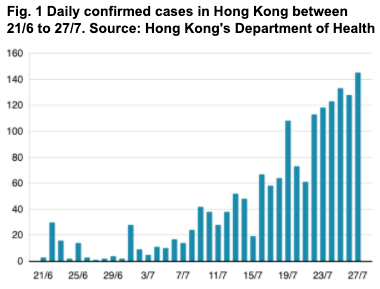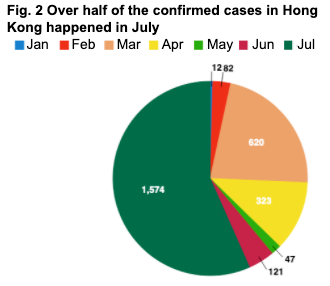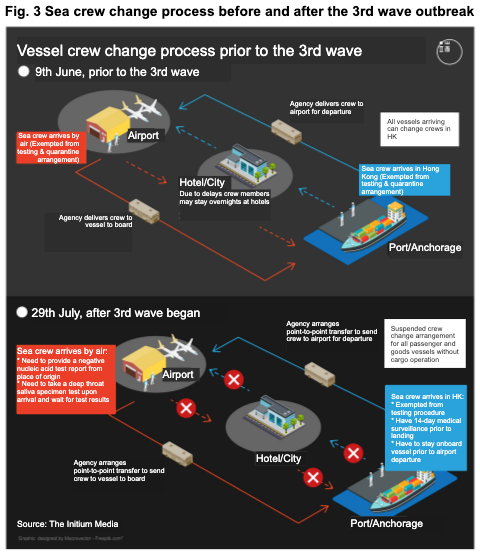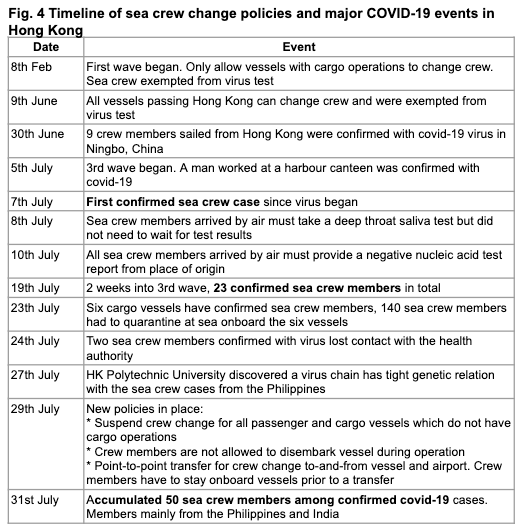COVID-19 has disrupted most industries and shipping is no exception. In this article we look into sea crew change policies in relation to the sea crew members confirmed with COVID-19 in Hong Kong. We reveal the threats the shipping industry is facing under the circumstances and detail how goPassport, a real-time COVID-19 alert system, could help the situation.


Figure 1 above shows the daily confirmed cases of COVID-19 in Hong Kong between 21st June to 27th July 2020. Figure 2 shows that the cases confirmed in July alone accounts for over 50% of all the confirmed cases in Hong Kong since the outbreak. Hong Kong is in the top 5 most densely populated places in the world so even though the number of confirmed cases is relatively small, every untraceable case could potentially cause a serious outbreak.
What happened in June and July? What caused the third wave in Hong Kong?
 On 9th June, after an improvement in the COVID-19 situation, the Hong Kong Government decided to relax the sea crew change policy to allow all vessels arriving in Hong Kong to change crew. Furthermore, sea crew members were granted exemption from virus test and quarantine procedures. (See Figure 3). During this period, sea crew members could stay in hotels and walk around the city when they waited for transit. In the meantime, the Hong Kong ports peaked in traffic as many vessel owners took this golden opportunity to change crews while other neighbouring countries were closed. On 7th July, Hong Kong confirmed its first case of COVID-19 among sea crew. In the following weeks the increase was significant and the consequence of the disease spreading in the city brought a new lock-down. On 29th July, the crew change policy was tightened up again and by 31st July, confirmed sea crew cases had risen to 50 (see timeline in Figure 4).
On 9th June, after an improvement in the COVID-19 situation, the Hong Kong Government decided to relax the sea crew change policy to allow all vessels arriving in Hong Kong to change crew. Furthermore, sea crew members were granted exemption from virus test and quarantine procedures. (See Figure 3). During this period, sea crew members could stay in hotels and walk around the city when they waited for transit. In the meantime, the Hong Kong ports peaked in traffic as many vessel owners took this golden opportunity to change crews while other neighbouring countries were closed. On 7th July, Hong Kong confirmed its first case of COVID-19 among sea crew. In the following weeks the increase was significant and the consequence of the disease spreading in the city brought a new lock-down. On 29th July, the crew change policy was tightened up again and by 31st July, confirmed sea crew cases had risen to 50 (see timeline in Figure 4).
 The Hong Kong Polytechnic University discovered a virus chain in the community with a tight genetic relation to the import sea crew cases from the Philippines. This discovery clearly indicated the relationship between the local community outbreak and the sea crew cases.
The Hong Kong Polytechnic University discovered a virus chain in the community with a tight genetic relation to the import sea crew cases from the Philippines. This discovery clearly indicated the relationship between the local community outbreak and the sea crew cases.
It is not surprising to see how the story unfolds. Disease transmission experts have pointed out repeatedly that having tight border control is crucial to stop international COVID-19 transmission. A relaxed immigration policy without a monitoring procedure is simply asking for trouble.
To the shipping companies and crew members, it must have been a dramatic ride with joy and tears to have the door closed then open and closed again within days. Many of us who live on land do not know the hardship at sea. Once I was onboard a container vessel to meet a team of sea crew and to hear their stories. Sea crews normally have a shift of anywhere from a few months up to a year. Onboard a vessel all they can see is ocean, sun or storm. While docking, crew members have only a few hours to attend to too many vessel duties, making it hard for them to go onland. It is psychologically demanding to keep spirits up and difficult being away from families for months in such conditions. Under COVID-19 when most ports are closed, many sea crew members cannot end their shift and some of them have already stayed at sea for 18 months. Similarly, stand-by crew members have remained jobless for a long time while waiting for an opportunity to rotate onboard.
The revised point-to-point transit and 14-day quarantine at sea crew change process has many practical challenges (see Figure 3). First of all, flights are limited under COVID restrictions so having a matching transit date between vessel and flight schedule is already challenging if at all possible. Secondly crew members have to quarantine at sea for 14 days before disembarking and a vessel may need to sit and wait for 20 days before it can sail again to another port – both of which can add to total days spent away. Since there is no guarantee the vessel is virus-free to enter another port, they may end up needing to quarantine at subsequent ports too. This process alone potentially puts many vessels and surrounding logistics services out of business.
Instead of having fully-opened or fully-closed policies, goPassport can play an important role to offer a data-driven, scenario-based approach to restart the crew change process. goPassport can:
- Guide crew members through health monitoring procedures prior to a crew change process, including a health test report issued by an approved clinic
- Monitor crew members prior-to and after the crew change to ensure crew members have not been exposed to high-risk conditions and have not gone off-track which may spread virus to the transit location
- Monitor and health check third party vessel visitors, e.g. inspectors, to ensure they do not bring virus onboard a vessel
- Provide port operators with an oversight of the health risk at a port, including the health rating of individual vessels and operating participants at port. Port operators and border control authorities are given health and risk data that they can base operational decisions on.
Since we are as yet unable to see the end of COVID-19 and its impact, we need to seek alternative ways to continue lives and operations. It is time to look into viable solutions like goPassport to regain control and to start a new normal. Bring the sea crew home.
Frances Luk
Managing Partner, AlphaZetta UK & Nordics
Credits to The Initium Media for an in-depth analysis
Other source: BBC
News Categories


